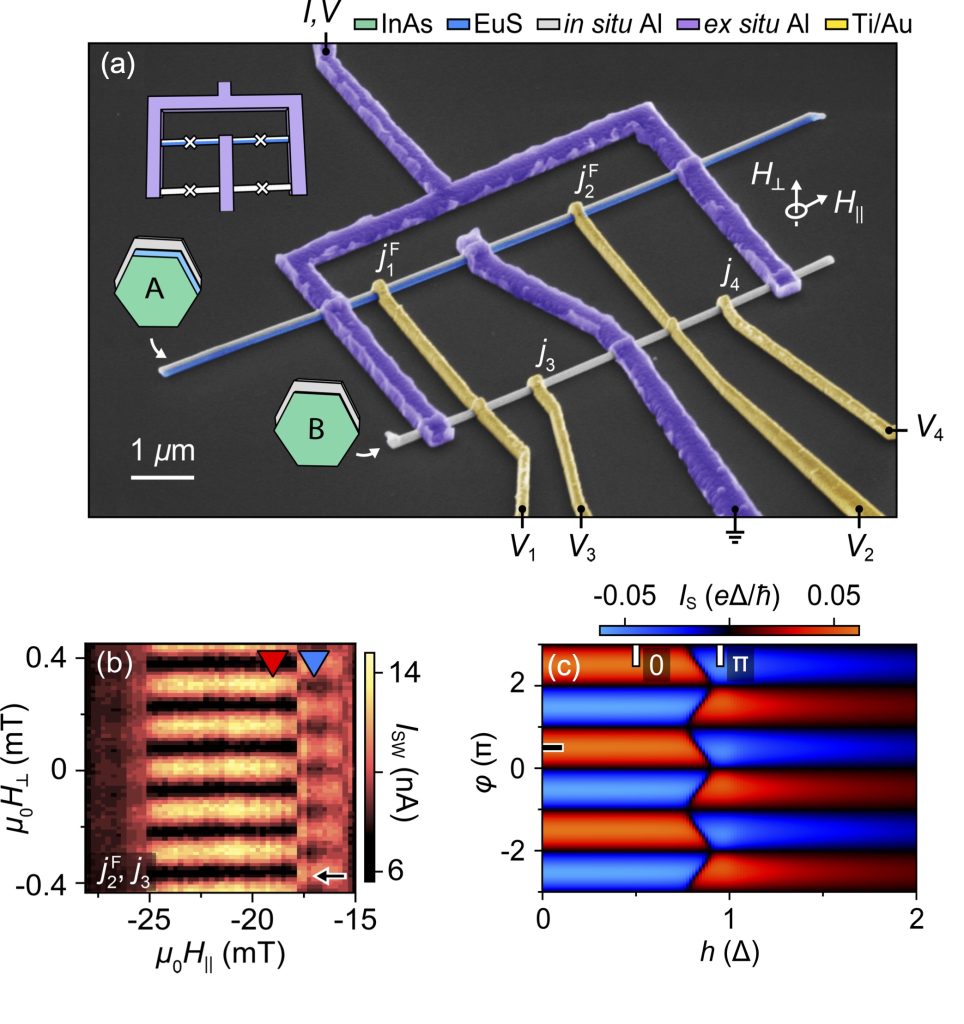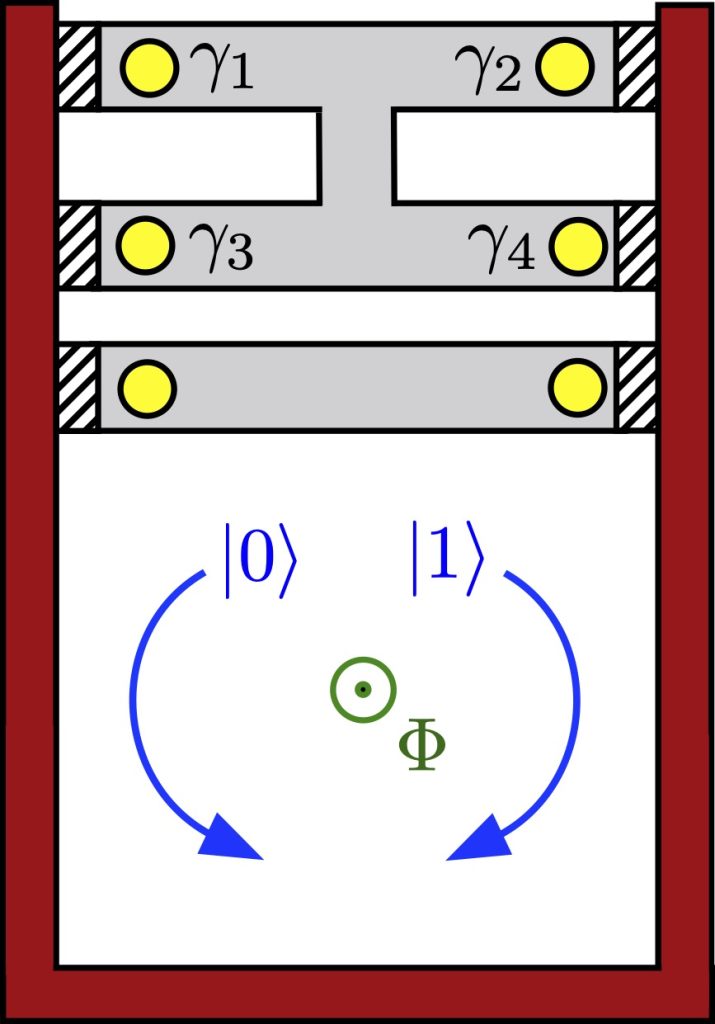Novel Superconducting Qubits

Illustration of an error-protected “0-Pi“ superconducting qubit, realized with an array of concatenated supercurrent interferometers of gate-tunable nanowire Josephson junction. Figure is adopted from our work, PRX Quantum 3, 030303 (2022).
Superconducting quantum circuits have emerged as a leading platform for a prospective quantum computer. Currently, a particular architecture, known as the transmon qubit, stands out as one of the most widely used encodings of quantum information in these circuits. Its popularity arises from the simplicity of its circuit design and its insensitivity to charge noise, a common source of error in superconducting devices. To learn more about the success story of the transmon, you can refer to: Review 1, Review 2.
Despite its many favorable attributes, it is important to acknowledge though that the transmon superconducting qubit is not perfect. For example, it lacks a built-in protection mechanism against relaxation errors caused by dielectric loss or non-equilibrium quasiparticles. These factors limit the depth of quantum circuits and algorithms that are executable on superconducting quantum computers. Thus, an important question in our community is: How we can improve the protection superconducting qubits against environmental noise?
Our research group is deeply interested in this research direction. Specifically, we focus on the overarching question of how new quantum materials can be used for developing novel error-protected superconducting qubit devices? So far, we have addressed this question (as part of a team with researchers from the Niels Bohr Institute and CU Boulder) by developing a 0-Pi superconducting qubit based on interferometers of hybrid superconductor-semiconductor Josephson junctions. These unique Josephson junctions provide the source for a supercurrent that is both highly transmissive and voltage-tunable. In our qubit design, we have harnessed both of these distinctive features to engineer an unusual charge 4e-supercurrent, carried by the simultaneous transport of pairs of Cooper pairs. Crucially, the Josephson potential describing this charge-4e supercurrent exhibits two distinct valleys, providing a qubit encoding that intrinsically protects against bit-flip errors. As a bonus, we have also shown that concatenating multiple interferometers can render our 0-Pi qubit insensitive to flux noise.
Recently, in collaboration with researchers at the University of Basel and IST Austria, we have identified experimental evidence for our predicted charge-4e supercurrent — a crucial step towards a protected superconducting qubit. We will continue to explore this direction theoretically and with our experimental collaborators. Moreover, we also aim to investigate other novel superconducting qubit encodings, such as fluxonium qubits and Andreev spin qubits.
High-Fidelity Control of Superconducting Qubits
Recent advances in quantum information encodings, such as the 0-Pi circuit and the fluxonium qubit, have opened up exciting possibilities for error-protected quantum information storage. However, the operation frequencies of these novel error-protected qubit designs are substantially reduced, hovering around 100 MHz, a stark contrast to the well-known GHz frequency range of superconducting transmon qubits. This shift in operational frequency presents an exciting challenge: How do we adapt gate-control and qubit readout for these new superconducting qubit designs? Clearly: “Novel qubits require novel control schemes“!
Motivated by this challenge, our research groups works on the development and optimization of novel control schemes for superconducting qubits. In our previous work, we have theoretically developed the first heterogeneous superconducting quantum computing architecture, enabling fast and high-fidelity qubit gates between error-protected low-frequency qubits and high-frequency superconducting transmon qubits. This heterogenous approach aims to synergize the robust quantum information storage capabilities of low-frequency qubits, serving as quantum memories, with the well-established computational capabilities of superconducting transmon qubits. Additionally, we have also explored novel gate protocols for architectures based on protected superconducting qubits. Specifically, in a joint work with collaborators from the Niels Bohr Institute and CU Boulder, we have developed multi-qubit gates for protected 0-Pi qubits.
Moving forward, we will continue to explore this direction with a focus on optimal control techniques and an expansion to the domain of superconducting qubit readout. These lines of research will provide new avenues for optimized operation of superconducting quantum processors, which is a crucial component for quantum algorithms and quantum error correction protocols.

Schematic of a heterogeneous superconducting quantum computing system, integrating transmon superconducting qubits with low-frequency superconducting qubits, specifically “0-Pi” qubits (as illustrated) or fluxonium qubits. Our work in PRX Quantum 030329 (2022) introduces an efficient approach for a two-qubit entangling gate between these distinct qubit modalities.
Josephson Diodes in Superconducting Quantum Circuits
Josephson junctions are central to superconducting quantum circuits, with their defining feature being the critical current at which transport changes from dissipationless to dissipative. Traditionally, this critical current has been perceived as being independent of the current-bias direction. However, recent results in the condensed matter community have shown that, when symmetry-broken quantum materials act as interconnects between superconducting leads, this seemingly foundational concept can be violated. Emerging from these findings is a new class of Josephson junctions, the “Josephson diodes“, where the critical current exhibits a distinct bias direction dependence. This prompts a question of both theoretical and applied relevance: Can these newly discovered Josephson diodes enhance the functionality and capabilities of superconducting quantum circuits?
Our research group is very interested in developing such quantum circuit applications of Josephson diodes and exploring novel material systems for their realization. A noteworthy result in this direction (obtained with collaborators at Cornell) is that Quantum Material Josephson Diodes offer a means for achieving dissipationless third-order nonlinearities. Such third-order nonlinearities are useful for superconducting amplifiers and could open to the way to a new generation of amplifiers without the need of external biases and with enormously simplified the circuit designs. Furthermore, Josephson diode-based amplifiers have the added advantage of improved power handling capabilities. This important feature is attributed to their ability to facilitate three-wave mixing without adverse an Kerr effect, which otherwise leads to gain compression of the amplifier at high input power levels.
We are very interested to continue pursuing this exciting direction. We have already identified several material systems that can support Josephson diodes, from superconductor-semiconductor Andreev interferometers to magnetic Josephson junctions. Our goal is to optimize these diodes for the aforementioned applications in amplifiers and also explore new applications of dissipationless nonlinearities for bosonic qubit encodings and tunable coupling architectures.

(a) A magnetic Josephson diode, introducing a three-wave mixing nonlinearity without requiring external biases. Such a nonlinearity is a fundamental component of quantum-limited amplifiers, bosonic qubits, and tunable qubit couplers. (b) Three-wave mixing amplitude, g_3, of the magnetic Josephson diode versus the Zeeman fields, h_x and h_y. (c) Kerr coefficient, K, of the magnetic Josephson diode, which vanishes along distinct “banana”-shaped arcs in the phase diagram. Such Kerr-free three-wave mixing configurations can enhance the power handling of quantum-limited amplifiers. Figures are adopted from our work, arXiv:2310.12198.
- Proposal for a realizing dissipationless nonlinearities with quantum material Josephson diodes
- Proposal for Josephson diodes with Andreev interferometers
- Proposal for Josephson diodes with EuS/Al/InAs hybrid Josephson junctions
- Observation of the Josephson diode effect in InAs/Al interferometers
- Observation of the Josephson diode effect in Germanium/Al interferometers
Superconductor-Ferromagnet-Semiconductor Triple-Hybrid Materials
Superconductor-ferromagnet hybrids have long been studied due to their exciting applications for superconducting spintronics. Recently, a new avenue has opened up by merging superconductor-ferromagnet structures with strongly spin-orbit coupled semiconductors. In our research, we are interested in exploring unconventional Josephson effects in these triple hybrid materials.
In our earlier work, a major focus has been on understanding how the spin-textures due to domains in the ferromagnet and the spin-orbit coupling in the semiconductor can lead to unconventional Josephson effects. To address this question, we have collaborated with experimentalists at the Niels Bohr Institute on triple-hybrid supercurrent interferometers and explained an observed supercurrent reversal transition in these devices that arises from the discrete flipping of EuS magnetic domains.
In our future research, we will focus on both the fundamental and applied aspects of superconductor-ferromagnetic-semiconductor triple-hybrid materials. We are especially interested in discovering unique transport properties related to the magnetic domain structures in triply-hybrid materials. Moreover, we will also explore the potential of triple-hybrid for creating double-Cooper pair tunneling elements. These unique Josephson elements could find future applications in novel superconducting qubit designs with intrinsic error-protection capabilities.

(a) Superconducting quantum interference device for measuring the current-phase relation of EuS-InAs-Al Josephson junctions. (b) Observation of a supercurrent reversal transition (also known as a 0-Pi transition), induced by the magnetic domain structure of the ferromagnetic insulator, EuS. (c) Theory simulation of the observed supercurrent reversal transition. Figures are adopted from our experiment-theory collaboration, Phys. Rev. B 107, L081301 (2022).
Topological Quantum Systems
Utilizing topological properties of quantum mechanical wavefunctions for storing quantum information constitutes a promising route to error-protected quantum computing that has witnessed noteworthy advancements in recent years. However, there are still important outstanding challenges. Primarily, the generation and clear identification of topological wavefunctions, known as Majorana zero modes, is still an open question in our community. Similarly, the optimal approach for manipulating topological wavefunctions in alignment with current experimental technology still needs to be established.
In our research, we have explored these two questions from different angles. Jointly with collaborators from MIT, we introduced the first scheme for manipulating Majorana-based qubits using an all-superconducting design that seamlessly integrates with the well-developed superconducting qubit technology. In a collaboration with TU Delft, we have also undertaken first steps towards realizing our proposed platform by developing an approach for parity-readout of subgap states based on supercurrent measurements. Finally, we have also been developing new ways for realizing and controlling Majorana zero modes at effectively zero magnetic field. Such approaches could offer a distinct advantage as strong magnetic field adversely affect the superconducting components in candidate platforms for topological wavefunctions.
Looking ahead, we will continue to be interested in new strategies for realizing Majorana zero modes and in overcoming key challenges such as device disorder, which may lead to non-topological wavefunctions that can closely mimic the behavior of Majorana devices.

